An Assessment of the Pakistan Water Apportionment Accord of 1991
Abstract
:1. Introduction
2. Materials and Methods
2.1. Study Area
2.2. Evaluation of Historical Performance of WAA (1970–2015)
3. Results
3.1. Reliability
3.2. Resilience
3.3. Vulnerability
4. Discussion and Conclusions
Author Contributions
Funding
Acknowledgments
Conflicts of Interest
Disclaimer
References
- Rockström, J.; Steffen, W.; Noone, K.; Persson, Å.; Chapin, F.S., III; Lambin, E.F.; Lenton, T.M.; Scheffer, M.; Folke, C.; Schellnhuber, H.J. A safe operating space for humanity. Nature 2009, 461, 472. [Google Scholar] [CrossRef] [PubMed]
- Garrick, D.; Hall, J.W. Water security and society: Risks, metrics, and pathways. Annu. Rev. Environ. Resour. 2014, 39, 611–639. [Google Scholar] [CrossRef]
- Organisation for Economic Co-opearation and Development. OECD Environmental Outlook to 2050; OECD Publishing: Paris, France, 2012. [Google Scholar]
- Water, U. Water Security and the Global Water Agenda: A UN-Water Analytical Brief; UN University: Hamilton, ON, Canada, 2013. [Google Scholar]
- Gerlak, A.K.; House-Peters, L.; Varady, R.G.; Albrecht, T.; Zúñiga-Terán, A.; de Grenade, R.R.; Cook, C.; Scott, C.A. Water security: A review of place-based research. Environ. Sci. Policy 2018, 82, 79–89. [Google Scholar] [CrossRef]
- Dasgupta, P. Human Well-Being and the Natural Environment; Oxford University Press: Oxford, UK, 2001. [Google Scholar]
- Sachs, J.; McArthur, J.W.; Schmidt-Traub, G.; Kruk, M.; Bahadur, C.; Faye, M.; McCord, G. Ending Africa’s poverty trap. Brook. Pap. Econ. Act. 2004, 2004, 117–240. [Google Scholar] [CrossRef]
- Sullivan, C. Calculating a water poverty index. World Dev. 2002, 30, 1195–1210. [Google Scholar] [CrossRef]
- Vicente-Serrano, S.M.; Beguería, S.; López-Moreno, J.I. A multiscalar drought index sensitive to global warming: The standardized precipitation evapotranspiration index. J. Clim. 2010, 23, 1696–1718. [Google Scholar] [CrossRef]
- Bolognesi, T. The Water Vulnerability of Metro and Megacities: An Investigation of Structural Determinants. Nat. Resour. Forum 2015, 39, 123–133. [Google Scholar] [CrossRef]
- Jones, P.D.; Moberg, A. Hemispheric and large-scale surface air temperature variations: An extensive revision and an update to 2001. J. Clim. 2003, 16, 206–223. [Google Scholar] [CrossRef]
- Solomon, S.; Qin, D.; Manning, M.; Averyt, K.; Marquis, M. Climate Change 2007—The Physical Science Basis: Working Group I Contribution to the Fourth Assessment Report of the IPCC; Cambridge University Press: Cambridge, UK, 2007; Volume 4. [Google Scholar]
- Sheffield, J.; Wood, E.F. Projected changes in drought occurrence under future global warming from multi-model, multi-scenario, IPCC AR4 simulations. Clim. Dyn. 2008, 31, 79–105. [Google Scholar] [CrossRef]
- Dubrovsky, M.; Svoboda, M.D.; Trnka, M.; Hayes, M.J.; Wilhite, D.A.; Zalud, Z.; Hlavinka, P. Application of relative drought indices in assessing climate-change impacts on drought conditions in Czechia. Theor. Appl. Climatol. 2009, 96, 155–171. [Google Scholar] [CrossRef]
- Brown, C.; Meeks, R.; Ghile, Y.; Hunu, K. Is water security necessary? An empirical analysis of the effects of climate hazards on national-level economic growth. Philos. Trans. R. Soc. A Math. Phys. Eng. Sci. 2013, 371, 20120416. [Google Scholar] [CrossRef] [PubMed] [Green Version]
- Dadson, S.; Hall, J.W.; Garrick, D.; Sadoff, C.; Grey, D.; Whittington, D. Water security, risk, and economic growth: Insights from a dynamical systems model. Water Resour. Res. 2017, 53, 6425–6438. [Google Scholar] [CrossRef]
- IUCN. Pakistan Water Apportionment Accord for Resolving Inter-Provincial Water Conflicts–Policy Issues and Options; IUCN: Karachi, Pakistan, 2010.
- PILDAT. Inter-Provincial Water Issues in Pakistan; Background Paper; Pakistan Institute of Legislative Development and Transparency: Islamabad, Pakistan, 2011. [Google Scholar]
- Ramphal, S.S.; Sinding, S.W. Population Growth and Environmental Issues; Greenwood Publishing Group: Westport, CT, USA, 1996. [Google Scholar]
- Bughio, A. Cries of Manchar. In Hayatee Magazine; Sindh Graduates Association: Karachi, Pakistan, 1999. [Google Scholar]
- Government of Pakistan. Statistical Supplement of Economic Survey 2006–07; Ministry of Finance: Islamabad, Pakistan, 2008.
- Khan, H.; Khan, A. Natural Hazards and Disaster Management in Pakistan; Munich University Library: Munich, Germany, 2008. [Google Scholar]
- Kurosaki, T. Vulnerability of household consumption to floods and droughts in developing countries: Evidence from Pakistan. Environ. Dev. Econ. 2015, 20, 209–235. [Google Scholar] [CrossRef]
- Sindh Forest Department. Provincial Working Group, Government of Sindh: Sukkur, Pakistan, 2002. Available online: https://sindhforests.gov.pk/ (accessed on 29 June 2019).
- Khalid, I.; Begum, I. Hydro Politics in Pakistan: Perceptions and Misperceptions. South Asian Stud. 2013, 28, 7–23. [Google Scholar]
- Khan, A.H. Water Sharing Dispute in Pakistan: Standpoint of Provinces. Berkeley J. Soc. Sci. 2014, 4, 1–17. [Google Scholar]
- Magsi, H.; Atif, S. Water management, impacts and conflicts: Case of indus water distribution in Sindh, Pakistan. Int. J. Rural Stud. 2012, 19, 3–7. [Google Scholar] [CrossRef]
- Bhatti, M.; Farooq, M. Politics of Water in Pakistan. Pak. J. Soc. Sci. 2014, 34, 205–216. [Google Scholar]
- WWF. Development of the Integrated Water Resources Management (IRBM) for Indus Basin Challenges and Opportunities; WWF Pakistan: Lahore, Pakistan, 2012. [Google Scholar]
- Anwar, A.A.; Bhatti, M.T. Pakistan’s water apportionment Accord of 1991: 25 years and beyond. J. Water Resour. Plan. Manag. 2017, 144, 05017015. [Google Scholar] [CrossRef]
- González, F.J.; Basson, T.; Schultz, B. Final Report of IPOE for Review of Studies on Water Escapages below Kotri Barrage; Unpublished report by an international panel of experts; Pakistan, 2005. [Google Scholar]
- Archer, D. Contrasting hydrological regimes in the upper Indus Basin. J. Hydrol. 2003, 274, 198–210. [Google Scholar] [CrossRef]
- Archer, D.R.; Forsythe, N.; Fowler, H.J.; Shah, S.M. Sustainability of water resources management in the Indus Basin under changing climatic and socio economic conditions. Hydrol. Earth Syst. Sci. 2010, 14, 1669–1680. [Google Scholar] [CrossRef] [Green Version]
- Wescoat, J.L., Jr. Managing the Indus River basin in light of climate change: Four conceptual approaches. Glob. Environ. Chang. 1991, 1, 381–395. [Google Scholar] [CrossRef]
- Akhtar, M.; Ahmad, N.; Booij, M.J. Use of regional climate model simulations as input for hydrological models for the Hindukush-Karakorum-Himalaya region. Hydrol. Earth Syst. Sci. 2009, 13, 1075–1089. [Google Scholar] [CrossRef] [Green Version]
- Patz, A.; Lang, K.; King, J.; Hillmann, P.; Condon, E. Resource Disputes in South Asia: Water Scarcity and the Potential for Interstate Conflict. Ph.D. Thesis, University of Wisconsin–Madison, Madison, WI, USA, 2009. [Google Scholar]
- Arfan, M.; Lund, J.; Hassan, D.; Saleem, M.; Ahmad, A. Assessment of Spatial and Temporal Flow Variability of the Indus River. Resources 2019, 8, 103. [Google Scholar] [CrossRef]
- Yang, Y.-C.E.; Brown, C.; Yu, W.; Wescoat, J., Jr.; Ringler, C. Water governance and adaptation to climate change in the Indus River Basin. J. Hydrol. 2014, 519, 2527–2537. [Google Scholar] [CrossRef] [Green Version]
- Ali, G.; Hasson, S.; Khan, A.M. Climate Change: Implications and Adaptation of Water Resources in Pakistan; Global Change Impact Studies Centre (GCISC): Islamabad, Pakistan, 2009.
- Laghari, A.; Vanham, D.; Rauch, W. The Indus basin in the framework of current and future water resources management. Hydrol. Earth Syst. Sci. 2012, 16, 1063. [Google Scholar] [CrossRef]
- Montgomery, D.C.; Runger, G.C. Applied Statistics and Probability for Engineers; John Wiley & Sons: Hoboken, NJ, USA, 2010. [Google Scholar]
- Fiering, M.B. Alternative indices of resilience. Water Resourc Res. 1982, 18, 33–39. [Google Scholar] [CrossRef]
- Duckstein, L.; Plate, E.J. A system framework for hydrological reliability with application to the design of structures. IAHS AISH Publ. 1985, 213–223. [Google Scholar]
- Kindler, J.; Tyszewski, S. Multicriteria evaluation of decision rules in the design of a storage reservoir. In Closing the Gap Between Theory and Practice; IAHS Publ. No. 180; IAHS: Wallingford, UK, 1989; pp. 187–201. [Google Scholar]
- Kundzewicz, Z.W. Renewal Theory Criteria of Evaluation of Water-Resource Systems: Reliability and ResiliencePaper presented at ICWRS-Workshop on Risk and Uncertainty in Hydrologic Design Oslo, Norway, February-1989. Hydrol. Res. 1989, 20, 215–230. [Google Scholar] [CrossRef]
- Kim, U.; Kaluarachchi, J.J. Climate Change Impacts on Water Resources in the Upper Blue Nile River Basin, Ethiopia 1. Jawra J. Am. Water Resour. Assoc. 2009, 45, 1361–1378. [Google Scholar] [CrossRef]
- Asefa, T.; Clayton, J.; Adams, A.; Anderson, D. Performance evaluation of a water resources system under varying climatic conditions: Reliability, Resilience, Vulnerability and beyond. J. Hydrol. 2014, 508, 53–65. [Google Scholar] [CrossRef]
- Hashimoto, T.; Loucks, D.P.; Stedinger, J.R. Robustness of water resources systems. Water Resour. Res. 1982, 21–26. [Google Scholar] [CrossRef]
- Holling, C.S. Resilience and stability of ecological systems. Annu. Rev. Ecol. Syst. 1973, 4, 1–23. [Google Scholar] [CrossRef]
- Moy, W.S.; Cohon, J.L.; ReVelle, C.S. A programming model for analysis of the reliability, resilience, and vulnerability of a water supply reservoir. Water Resour. Res. 1986, 22, 489–498. [Google Scholar] [CrossRef]
- Smit, B.; Wandel, J. Adaptation, adaptive capacity and vulnerability. Glob. Environ. Chang. 2006, 16, 282–292. [Google Scholar] [CrossRef]
- Rosenzweig, C.; Tubiello, F.N. Developing Climate Change Impacts and Adaptation Metrics for Agriculture. In Proceedings of the Global Forum on Sustainable Development on the Economic Benefits of Climate Change Policies, Paris, France, 24–25 October 2006. [Google Scholar]
- Wang, C.-H.; Blackmore, J.M. Resilience concepts for water resource systems. J. Water Resour. Plan. Manag. 2009, 135, 528–536. [Google Scholar] [CrossRef]
- International Commission on Irrigation and Drainage (ICID). 2010. Available online: https://www.icid.org/ (accessed on 29 June 2019).
- Mondal, M.S.; Wasimi, S.A. Evaluation of risk-related performance in water management for the Ganges Delta of Bangladesh. J. Water Resour. Plan. Manag. 2007, 133, 179–187. [Google Scholar] [CrossRef]
- Francis, R.; Bekera, B. A metric and frameworks for resilience analysis of engineered and infrastructure systems. Reliab. Eng. Syst. Saf. 2014, 121, 90–103. [Google Scholar] [CrossRef]
- Wong, T.H.; Brown, R.R. The water sensitive city: Principles for practice. Water Sci. Technol. 2009, 60, 673–682. [Google Scholar] [CrossRef]
- Woods, D.D. Four concepts for resilience and the implications for the future of resilience engineering. Reliab. Eng. Syst. Saf. 2015, 141, 5–9. [Google Scholar] [CrossRef]
- Schoen, M.; Hawkins, T.; Xue, X.; Ma, C.; Garland, J.; Ashbolt, N.J. Technologic resilience assessment of coastal community water and wastewater service options. Sustain. Water Qual. Ecol. 2015, 6, 75–87. [Google Scholar] [CrossRef]
- Fiksel, J. Designing resilient, sustainable systems. Environ. Sci. Technol. 2003, 37, 5330–5339. [Google Scholar] [CrossRef] [PubMed]
- Chanda, K.; Maity, R.; Sharma, A.; Mehrotra, R. Spatiotemporal variation of long-term drought propensity through reliability-resilience-vulnerability based Drought Management Index. Water Resour. Res. 2014, 50, 7662–7676. [Google Scholar] [CrossRef]
- Pimm, S.L. The complexity and stability of ecosystems. Nature 1984, 307, 321. [Google Scholar] [CrossRef]
- Tilman, D.; Downing, J.A. Biodiversity and stability in grasslands. Nature 1994, 367, 363. [Google Scholar] [CrossRef]
- Walker, B.H.; Ludwig, D.; Holling, C.S.; Peterman, R.M. Stability of semi-arid savanna grazing systems. J. Ecol. 1981, 473–498. [Google Scholar] [CrossRef]
- Holling, C.S. Engineering resilience versus ecological resilience. Eng. Ecol. Constraints 1996, 31, 32. [Google Scholar]
- Kjeldsen, T.R.; Rosbjerg, D. Choice of reliability, resilience and vulnerability estimators for risk assessments of water resources systems/Choix d’estimateurs de fiabilité, de résilience et de vulnérabilité pour les analyses de risque de systèmes de ressources en eau. Hydrol. Sci. J. 2004, 49, 767. [Google Scholar] [CrossRef]
- Adger, W.N. Vulnerability. Glob. Environ. Chang. 2006, 16, 268–281. [Google Scholar] [CrossRef]
- McCarthy, J.J.; Canziani, O.F.; Leary, N.A.; Dokken, D.J.; White, K.S. Climate Change 2001: Impacts, Adaption, and Vulnerability; Cambridge University Press: Cambridge, UK, 2001. [Google Scholar]
- Jain, S.; Bhunya, P. Reliability, resilience and vulnerability of a multipurpose storage reservoir/Confiance, résilience et vulnérabilité d’un barrage multi-objectifs. Hydrol. Sci. J. 2008, 53, 434–447. [Google Scholar] [CrossRef]
- Sandoval-Solis, S.; McKinney, D.; Loucks, D. Sustainability index for water resources planning and management. J. Water Resour. Plan. Manag. 2010, 137, 381–390. [Google Scholar] [CrossRef]
- Fowler, H.; Kilsby, C.; O’Connell, P. Modeling the impacts of climatic change and variability on the reliability, resilience, and vulnerability of a water resource system. Water Resour. Res. 2003, 39. [Google Scholar] [CrossRef] [Green Version]
- Ajami, N.K.; Hornberger, G.M.; Sunding, D.L. Sustainable water resource management under hydrological uncertainty. Water Resour. Res. 2008, 44. [Google Scholar] [CrossRef] [Green Version]
- O’Brien, K.; Eriksen, S.E.; Schjolden, A.; Nygaard, L.P. What’s in a Word? Conflicting Interpretations of Vulnerability in Climate Change Research; Center for International Climate and Environmental Research: Oslo, Norway, 2004. [Google Scholar]
- Jinno, K. Risk assessment of a water supply system during drought. Int. J. Water Resour. Dev. 1995, 11, 185–204. [Google Scholar] [CrossRef]
- Jenks, G.F. The data model concept in statistical mapping. Int. Yearb. Cartogr. 1967, 7, 186–190. [Google Scholar]
- Chen, D.C.; Maksimovic, C.; Voulvoulis, N. Institutional capacity and policy options for integrated urban water management: A Singapore case study. Water Policy 2011, 13, 53–68. [Google Scholar] [CrossRef]
- Luan, I.O.B. Singapore water management policies and practices. Int. J. Water Resour. Dev. 2010, 26, 65–80. [Google Scholar] [CrossRef]
- Tortajada, C. Water management in Singapore. Int. J. Water Resour. Dev. 2006, 22, 227–240. [Google Scholar] [CrossRef]


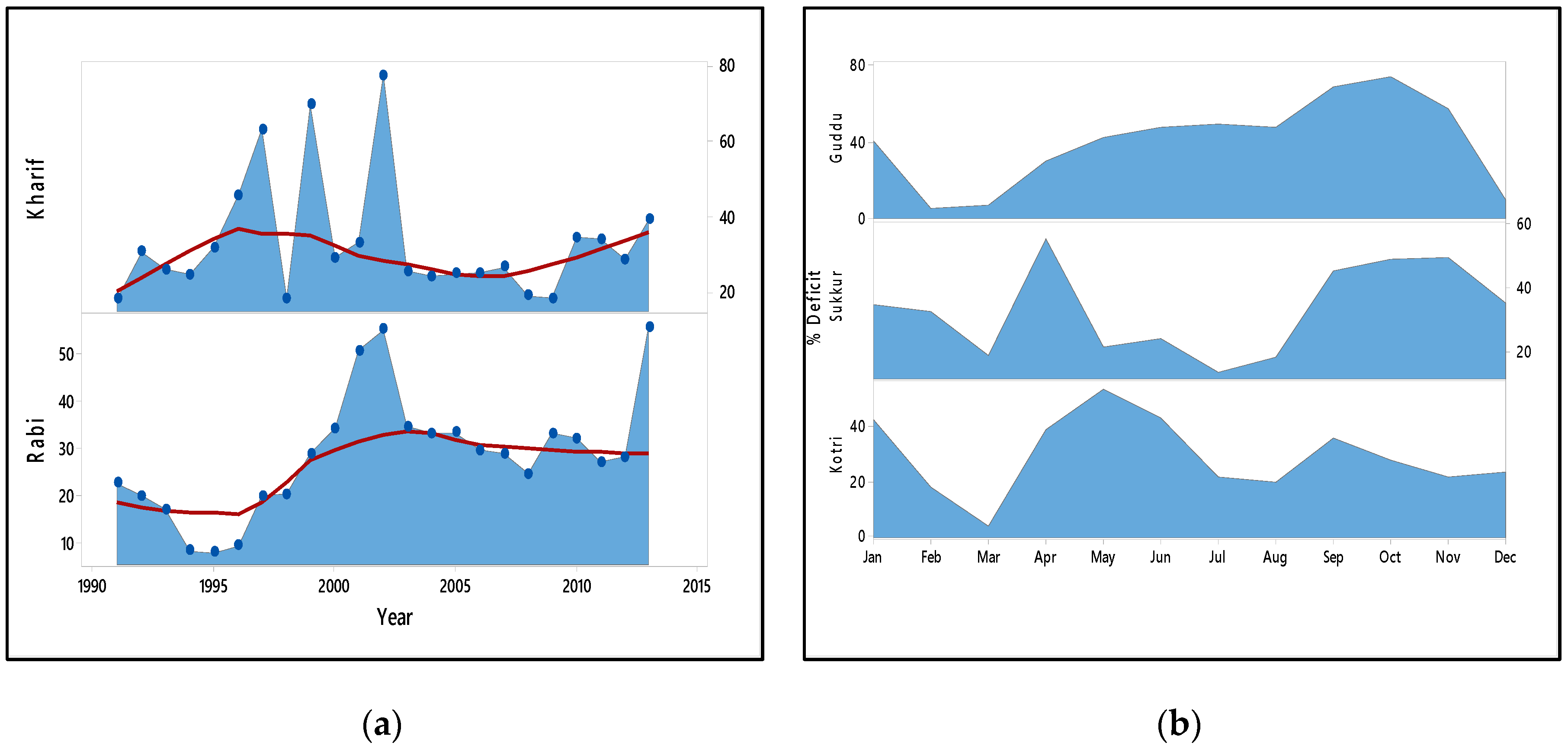
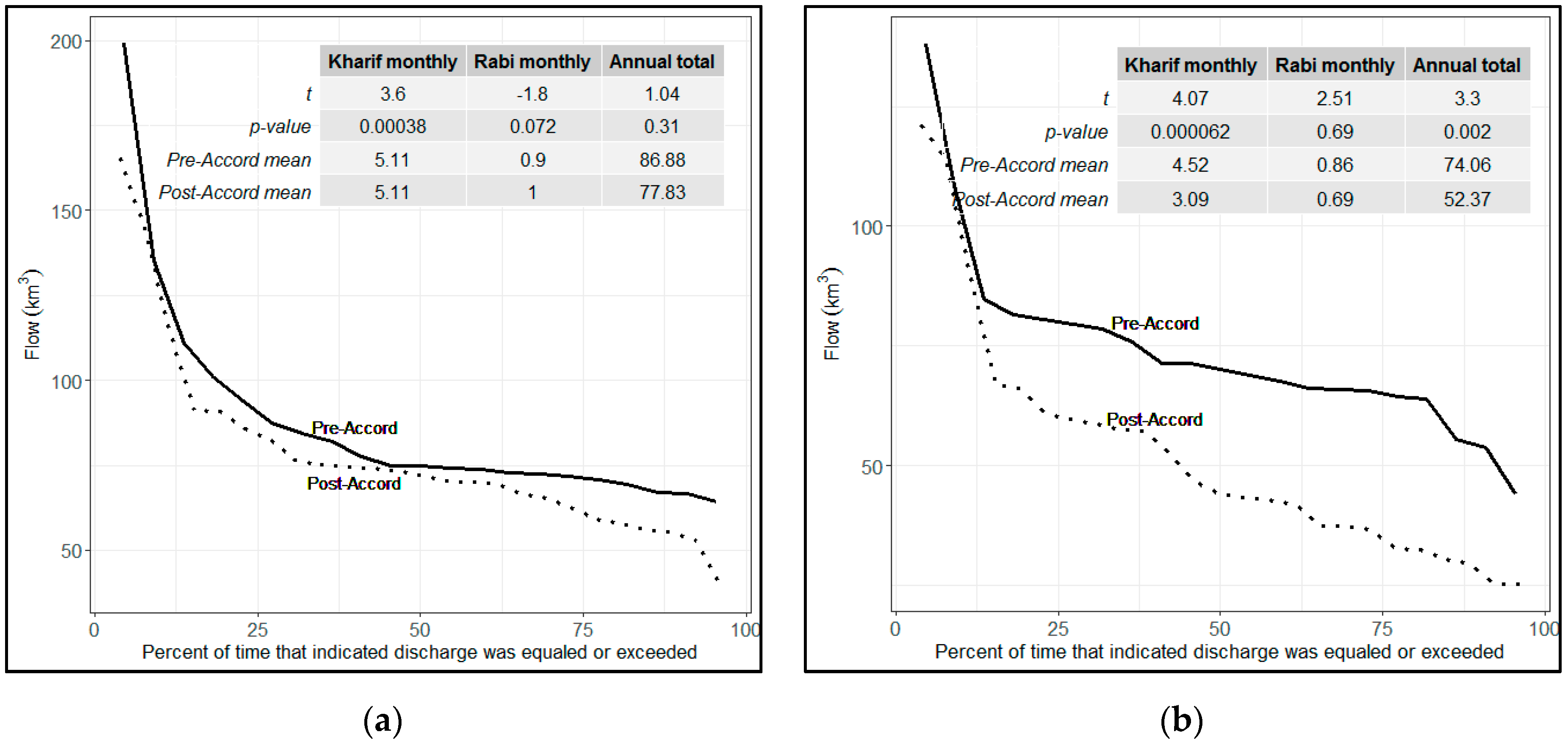
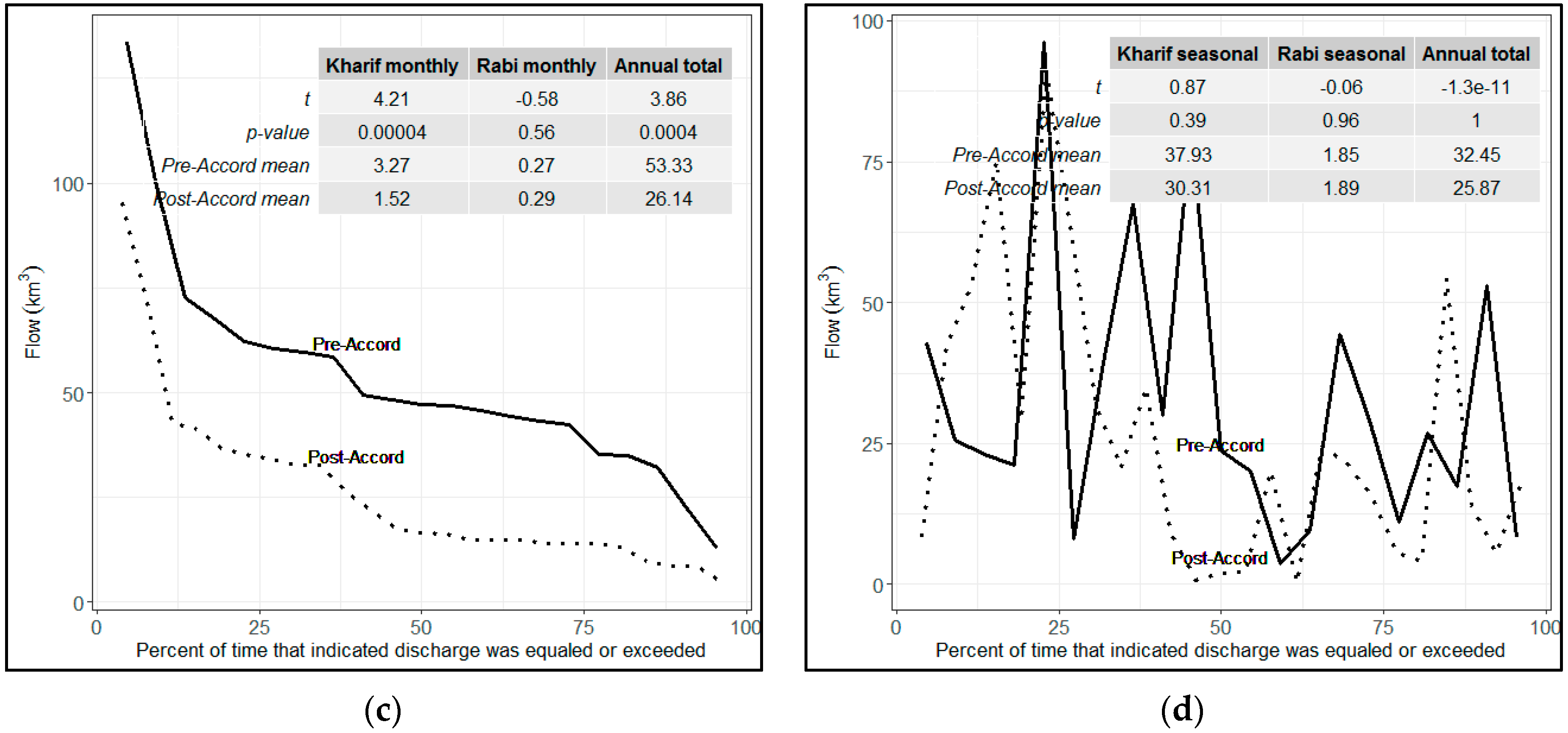
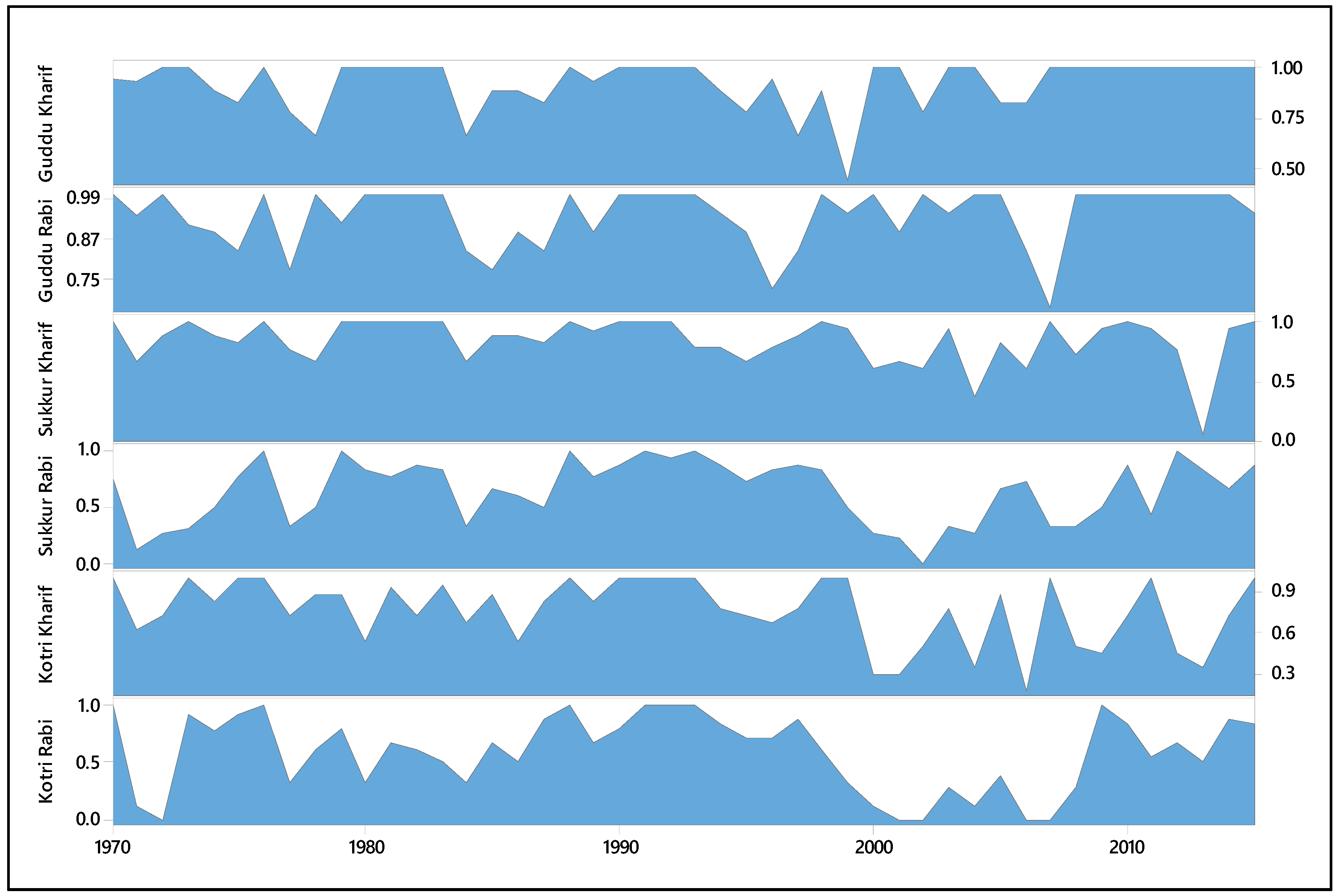
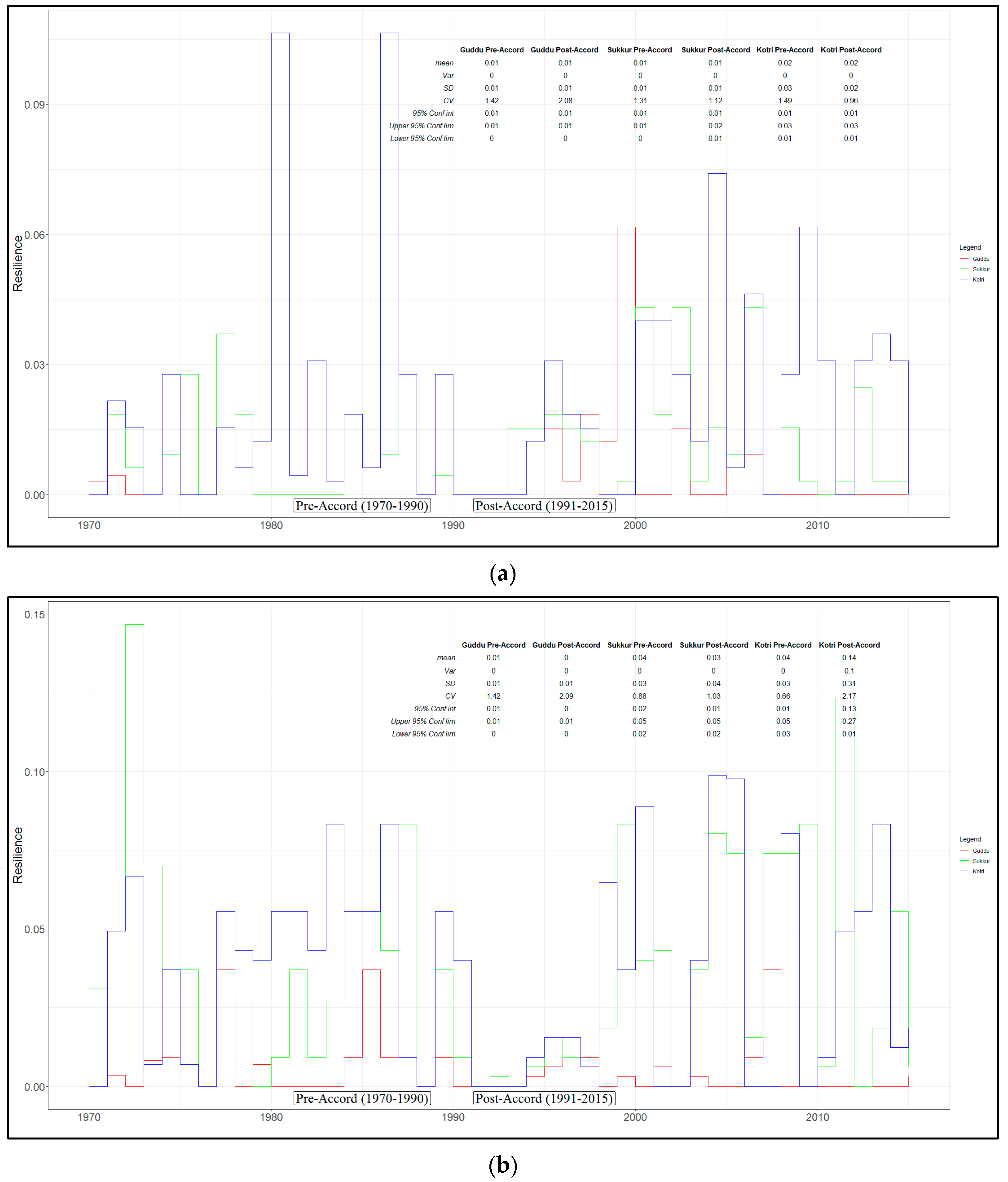
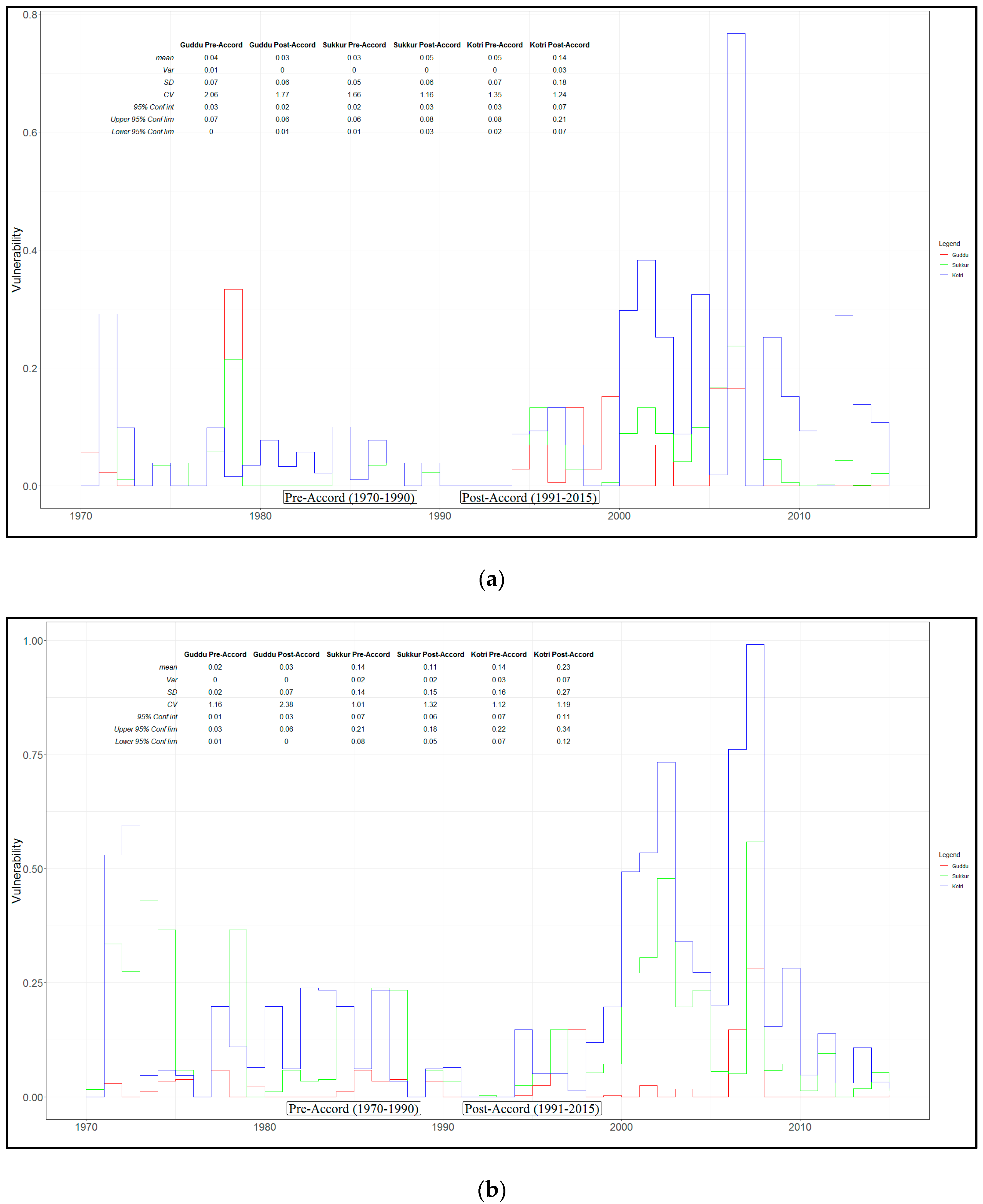
| Pre Accord (1970–1990) | ||||||||
|---|---|---|---|---|---|---|---|---|
| Guddu Kharif | Guddu Rabi | Sukkur Kharif | Sukkur Rabi | Kotri Kharif | Kotri Rabi | Below Kotri Kharif | Below Kotri Rabi | |
| mean | 5.11 | 0.90 | 4.52 | 0.86 | 3.27 | 0.27 | 37.90 | 1.85 |
| median | 3.93 | 0.85 | 3.37 | 0.75 | 1.73 | 0.16 | 31.32 | 0.54 |
| Variance | 21.65 | 0.31 | 16.01 | 0.60 | 23.36 | 0.12 | 813.00 | 7.45 |
| Standard Deviation | 4.65 | 0.56 | 4.00 | 0.77 | 4.83 | 0.35 | 28.51 | 2.73 |
| Coefficient of Variation | 0.91 | 0.62 | 0.89 | 0.90 | 1.48 | 1.28 | 0.75 | 1.48 |
| Standard Error of the Mean | 0.35 | 0.05 | 0.31 | 0.06 | 0.40 | 0.03 | 6.22 | 0.60 |
| 95% confidence interval: | 0.70 | 0.09 | 0.61 | 0.12 | 0.78 | 0.06 | 12.97 | 1.24 |
| upper 95% confidence limit: | 5.81 | 0.99 | 5.13 | 0.98 | 4.05 | 0.33 | 50.91 | 3.09 |
| lower 95% confidence limit: | 4.41 | 0.81 | 3.91 | 0.73 | 2.48 | 0.21 | 24.95 | 0.60 |
| 25% | 1.46 | 0.70 | 1.20 | 0.44 | 0.26 | 0.07 | 0.07 | 21.46 |
| 50% | 3.09 | 0.94 | 2.31 | 0.64 | 0.80 | 0.15 | 0.15 | 31.32 |
| 75% | 4.56 | 1.16 | 3.63 | 0.83 | 1.65 | 0.34 | 0.34 | 47 |
| 100% | 27.68 | 3.46 | 22.54 | 2.45 | 16.00 | 6.12 | 6.12 | 115.56 |
| Post Accord (1991–2015) | |||||||
|---|---|---|---|---|---|---|---|
| Guddu Rabi | Sukkur Kharif | Sukkur Rabi | Kotri Kharif | Kotri Rabi | Below Kotri Kharif | Below Kotri Rabi | |
| mean | 1.00 | 3.09 | 0.69 | 1.52 | 0.29 | 30.31 | 1.88 |
| median | 0.94 | 2.31 | 0.64 | 0.80 | 0.15 | 22.30 | 0.82 |
| Variance | 0.26 | 8.59 | 0.18 | 4.68 | 0.24 | 875.65 | 4.90 |
| Standard Deviation | 0.51 | 2.93 | 0.42 | 2.16 | 0.49 | 29.60 | 2.21 |
| Coefficient of Variation | 0.51 | 0.95 | 0.61 | 1.42 | 1.66 | 0.97 | 1.17 |
| Standard Error of the Mean | 0.03 | 0.17 | 0.02 | 0.12 | 0.03 | 6.17 | 0.46 |
| 95% confidence interval: | 0.06 | 0.33 | 0.05 | 0.24 | 0.06 | 12.79 | 0.96 |
| upper 95% confidence limit: | 1.06 | 3.42 | 0.74 | 1.76 | 0.35 | 43.11 | 2.84 |
| lower 95% confidence limit: | 0.94 | 2.75 | 0.64 | 1.28 | 0.24 | 17.51 | 0.96 |
| 25% | 2.00 | 2.00 | 86.25 | 1.00 | 2.00 | 6.78 | 0.13 |
| 50% | 68.50 | 71.50 | 197.50 | 80.50 | 68.50 | 22.30 | 0.82 |
| 75% | 173.75 | 174.75 | 277.00 | 175.75 | 173.75 | 39.06 | 3.58 |
| 100% | 284 | 282 | 277 | 282 | 283 | 108.01 | 7.46 |
| Pre-Accord | Post-Accord | |||||
|---|---|---|---|---|---|---|
| Reliability | Resiliency | Vulnerability | Reliability | Resiliency | Vulnerability | |
| Kharif | 0.97 | 0.001 | 0.014 | 0.70 | 0.053 | 0.178 |
| Rabi | 0.47 | 0.12 | 0.357 | 0.32 | 0.093 | 0.537 |
| Annual | 0.92 | 0.01 | 0.019 | 0.70 | 0.053 | 0.201 |
© 2019 by the authors. Licensee MDPI, Basel, Switzerland. This article is an open access article distributed under the terms and conditions of the Creative Commons Attribution (CC BY) license (http://creativecommons.org/licenses/by/4.0/).
Share and Cite
Hassan, D.; Burian, S.J.; Bano, R.; Ahmed, W.; Arfan, M.; Naseer Rais, M.; Rafique, A.; Ansari, K. An Assessment of the Pakistan Water Apportionment Accord of 1991. Resources 2019, 8, 120. https://doi.org/10.3390/resources8030120
Hassan D, Burian SJ, Bano R, Ahmed W, Arfan M, Naseer Rais M, Rafique A, Ansari K. An Assessment of the Pakistan Water Apportionment Accord of 1991. Resources. 2019; 8(3):120. https://doi.org/10.3390/resources8030120
Chicago/Turabian StyleHassan, Daniyal, Steven J. Burian, Rakhshinda Bano, Waqas Ahmed, Muhammad Arfan, Muhammad Naseer Rais, Ahmed Rafique, and Kamran Ansari. 2019. "An Assessment of the Pakistan Water Apportionment Accord of 1991" Resources 8, no. 3: 120. https://doi.org/10.3390/resources8030120
APA StyleHassan, D., Burian, S. J., Bano, R., Ahmed, W., Arfan, M., Naseer Rais, M., Rafique, A., & Ansari, K. (2019). An Assessment of the Pakistan Water Apportionment Accord of 1991. Resources, 8(3), 120. https://doi.org/10.3390/resources8030120






